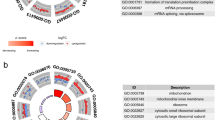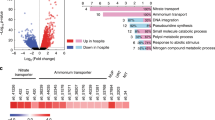Abstract
There is a correlation between the ability of symbiotic Chlorella algae to take up glucose and their survival in green hydra grown in continuous darkness. Although normal symbionts of European green hydra, which persist at a stable level in dark-grown animals, possessed no detectable constitutive ability to take up glucose when grown in light, uptake was induced after incubation in a medium containing glucose. Further, symbionts isolated from hydra grown in darkness for two weeks had acquired a constitutive uptake ability. Neither NC64A nor 3N813A strains of algae, in artificial symbiosis with hydra, persisted in dark-grown animals, and they showed little or no uptake ability, although in culture NC64A possessed both constitutive and inducible glucose-uptake mechanisms. In contrast, mitotic indices in all three types of algae in symbiosis with hydra increased after host feeding, indicating that the factor which stimulates algal cell division is not identical to the substrate utilised during heterotrophic growth.
Similar content being viewed by others
Abbreviations
- E/E:
-
normal Hydra-Chlorella symbiosis
- E/NC, E/3N:
-
artificial symbioses between Hydra and Chlorella strains NC64A and 3N813A, respectively
- 3-OMG:
-
3-O-methyl-D-glucose
- SDS:
-
sodium dodecyl sulfate
References
Cernichiari, E., Muscatine, L., Smith, D.C. (1969) Maltose excretion by the symbiotic algae of Hydra viridis. Proc. R. Soc. London Ser. B. 173, 557–576
Cook, C.B. (1972) Benefit to symbiotic zoochlorellae from feeding by green hydra. Biol. Bull. 142, 236–242
Cook, C.B., Kelty, M.O. (1982) Glycogen, protein, and lipid content of green, aposymbiotic, and nonsymbiotic hydra during starvation. J. Exp. Zool. 222, 1–9
David, C.N. (1973) A quantitative method for maceration of hydra tissue. Wilhelm Roux' Arch. Entwicklungsmech. Org. 171, 259–268
Decker, M., Tanner, W. (1972) Respiratory increase and active hexose uptake of Chlorella vulgaris. Biochim. Biophys. Acta. 266, 661–669
Douglas, A.E., Smith, D.C. (1983) The cost of symbionts to the host in the green hydra symbiosis. In: Endocytobiology, endosymbiosis and cell biology, pp. 631–648, Schwemmler, W., Schenk, H.E.A., eds. Walter de Gruyter, Berlin
Douglas, A.E., Smith, D.C. (1984) The green hydra symbiosis. VII. Mechanisms in symbiont regulation. Proc. R. Soc. London Ser. B. 221, 291–319
Droop, M.R. (1974) Heterotrophy of carbon. In: Algal physiology and biochemistry, pp. 530–559, Stewart, W.D.P. ed. Blackwell Scientific Publications
Fenzl, F., Decker, M., Haass, D., Tanner, W. (1977) Characterization and partial purification of an inducible protein related to hexose proton cotransport in Chlorella vulgaris. Eur. J. Biochem. 72, 509–514
Haass, D., Tanner, W. (1974) Regulation of hexose transport in Chlorella vulgaris. Characteristics of induction and turnover. Plant Physiol. 53, 14–20
Hellebust, J.A., Hunglin, Y.I. (1978) Uptake of organic solutes. In: Handbook of phycological methods. Physiological and biochemical methods, pp. 379–388, Hellebust, J.A., Craigie, J.S., eds. Cambridge University Press, Cambridge, UK
Jolley, E., Smith, D.C. (1978) The green hydra symbiosis. I. Isolation, culture and characteristics of the Chlorella symbiont of ‘European’ Hydra viridis. New Phytol. 81, 637–645
Kessler, E., Langer, W., Ludwig, I., Wiechmann, H. (1963) Bildung von Sekundaer-Carotinoiden bei Stickstoffmangel und Hydrogenase-Activataet als taxonomische Merkmale in der Gattung Chlorella. In: Studies on microalgae and photosynthetic bacteria, pp. 7–20, Japanese Society of Plant Physiology, University of Tokyo Press, Tokyo
Komor, E., Tanner, W. (1971) Characterization of the active hexose transport system of Chlorella vulgaris. Biochim. Biophys. Acta. 241, 170–179
Lenhoff, H.M., Brown, R. (1970) Mass culture of hydra: an improved method and its application to other aquatic invertebrates. Lab. Anim. 4, 139–154
McAuley, P.J. (1981) Ejection of algae in the green hydra symbiosis. J. Exp. Zool. 127, 23–31
McAuley, P.J. (1985a) The cell cycle of symbiotic Chlorella. I. The relationship between host feeding and algal cell growth and division. J. Cell Sci. 77, 225–239
McAuley, P.J. (1985b) The cell cycle of symbiotic Chlorella. II. The effect of continuous darkness. J. Cell Sci. 77, 241–253
McAuley, P.J. (1986) Isolation of viable uncontaminated symbiotic Chlorella from green hydra. Limnol. Oceangr. 31, 222–224
Mews, L. (1980) The green hydra symbiosis. III. The biotrophic transport of carbohydrate from alga to animal. Proc. R. Soc. London Ser. B. 209, 377–401
Mews, L., Smith, D.C. (1982) The green hydra symbiosis. VI. What is the role of maltose transfer from alga to animal? Proc. R. Soc. London Ser. B. 216, 397–413
Muscatine, L., Karakashian, S.J., Karakashian, M.W. (1967) Soluble extracellular products of algae symbiotic with a ciliate, sponge and a mutant hydra. Comp. Biochem. Physiol. 20, 1–12
Muscatine, L., Lenhoff, H.M. (1965) Symbiosis of hydra and algae. I. Effects of some environmental cations on growth of symbiotic and aposymbiotic hydra. Biol. Bull. 128, 415–424
Pardy, R.L. (1974) Some factors affecting the growth and distribution of the algal endosymbionts of Hydra viridis. Biol. Bull. 147, 105–118
Sauer, N., Tanner, W. (1983) Partial purification and characterization of inducible transport proteins in Chlorella. Z. Pflanzenphysiol. 114, 367–375
Tanner, W. (1969) Light driven active uptake of 3-O-Methylglucose via an inducible hexose uptake system of Chlorella. Biochem. Biophys. Res. Comm. 36, 278–283
Tanner, W., Grunes, R., Kandler, O. (1970) Spezifität und Turnover des induzierbaren Hexose-Aufnahmesystems von Chlorella. Z. Pflanzenphysiol. 62, 376–386
Thorington, G., Margulis, L. (1981) Hydra viridis: Transfer of metabolites between hydra and symbiotic algae. Biol. Bull. 160, 175–188
Weis, D.S. (1978) Correlation of infectivity and concanavalin A agglutinability of algae exsymbiotic from Paramecium bursaria J. Protozool. 25, 366–370
Wilkerson, F.P. (1981) Bacterial symbionts on green hydra and their effect on phosphate uptake. Microb. Ecol. 6, 85–92
Yoder, M.C. (1926) The occurrence, storage and distribution of glycogen in Hydra viridis and Hydra fusca, J. Exp. Zool. 44, 475–483
Author information
Authors and Affiliations
Rights and permissions
About this article
Cite this article
McAuley, P.J. Glucose uptake by symbiotic Chlorella in the green-hydra symbiosis. Planta 168, 523–529 (1986). https://doi.org/10.1007/BF00392272
Received:
Accepted:
Issue Date:
DOI: https://doi.org/10.1007/BF00392272




